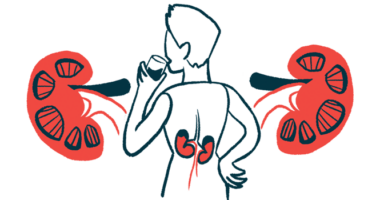Treating pregnancy-related aHUS early important for better outcomes: Study
Delay in diagnosis, treatment may have contributed to woman's kidney failure

A delay in diagnosing and treating a woman with pregnancy-related atypical hemolytic uremic syndrome (aHUS) may have contributed to her kidney failure, a U.S. case study suggests.
Her condition was first thought to be thrombotic thrombocytopenic purpura (TTP), a related blood disorder. Until she was finally diagnosed correctly with aHUS, the woman did not receive Soliris (eculizumab), an aHUS-approved therapy, and her kidney condition worsened.
While she responded well to Soliris, the damage to her kidneys was already very severe.
“In retrospect, we acknowledge that earlier treatment with [Soliris] over corticosteroids for immunosuppression might have prevented the severity of kidney injury,” researchers wrote in the case report “Atypical hemolytic uremic syndrome in a postpartum patient,” which was published in the journal BMJ Case Reports.
Similarities in clinical features pose challenge in differentiating disorders
aHUS and TTP are two types of a group of conditions called thrombotic microangiopathies, or TMAs. These are characterized by the formation of tiny blood clots in small blood vessels that block blood flow to important organs, especially the kidneys in the case of aHUS.
Typically, patients also show signs of red blood cell destruction (hemolysis) and have low counts of platelets, the tiny blood fragments that promote clotting.
aHUS is associated with excessive activation of the immune complement system, while TTP results from a deficiency in an enzyme called ADAMTS13. While infections are known to be the most common trigger of aHUS, pregnancy is thought to be a contributing factor to both conditions.
“The similarities in clinical features among the common TMAs pose a challenge to differentiating them,” the researchers wrote, adding “it is even more difficult to discover the [cause] of a specific TMA” in cases of infections and during the postpartum period.
Now, researchers at the Texas Tech University Health Sciences Center School of Medicine described the diagnostic challenge in a case of a woman in her late 30s who developed aHUS postpartum.
The woman had an uneventful pregnancy, although she had a history of abusing the recreational drug methamphetamine in her first trimester. She underwent a cesarean section without complications for her or her baby, and she was discharged after two days.
However, five days later, the woman was admitted to the emergency department due to chest pain, shortness of breath with exercise, generalized weakness, diarrhea, and vision changes.
On examination, she had high blood pressure, accelerated heart rate, and mild respiratory distress, but her body temperature was normal.
Blood work showed too much acid in her blood and severe anemia, or very low levels of hemoglobin, the protein in red blood cells that carries oxygen. The woman also had higher-than-normal levels of blood markers of liver, heart, and kidney damage.
Increased awareness and knowledge of the presentation of pregnancy-associated aHUS is needed.
Woman tested positive for COVID-19
She was also found to be positive for SARS-CoV-2, the virus that causes COVID-19, and showed lung abnormalities on a chest X-ray. No signs of bleeding in the abdomen were detected. The woman was admitted to the intensive care unit and further tests were conducted to identify the cause of her severe anemia, as well as kidney and liver damage.
Analysis of a blood sample showed red blood cell fragments, suggesting hemolysis. Testing for autoimmune conditions characterized by coagulation problems or hemolysis came back negative. She was positive for Yersinia enterocolitica, a bacterium that usually manifests as a gastrointestinal infection and can cause diarrhea.
Also, the woman was negative for Shiga toxins, which can induce hemolytic uremic syndrome, another type of TMA. An assay to assess the activity of ADAMTS13 was requested “but results were unavailable for 13 days as it was sent to an outside reference laboratory,” the researchers wrote.
At this point, the clinicians considered three potential diagnoses: TTP, aHUS, and hemolysis-elevated liver enzyme-low platelet (HELLP) syndrome, which is a life-threatening pregnancy complication.
After concluding that HELLP was “highly unlikely due to presentation 1 week after pregnancy and the prolonged course of illness,” the team focused on TTP and aHUS, which could also explain better the presence of red blood cell fragments in the blood.
Before the ADAMTS13 test results came back, the woman received five units of red blood cells, one unit of platelets, and six courses of plasma exchange (a blood-cleaning procedure), and hemodialysis (a procedure that does the work of kidneys) every other day.
She was also given the immunosuppressant methylprednisolone, a glucocorticoid, to treat TTP, with plans to discontinue it if her ADAMSTS13 results came back normal.
Her red blood cell counts started to increase, and organ damage markers normalized.
Normal ADAMSTS13 test results confirm aHUS diagnosis
In the meantime, her ADAMSTS13 test came back normal, confirming an aHUS diagnosis. She was then started on Soliris, an aHUS-approved therapy designed to suppress complement system activation, and plasma exchange was discontinued.
Once on Soliris, her hemoglobin levels increased and she no longer required red blood cell transfusions. No treatment for COVID-19 was required.
About a month after she was first admitted to hospital, the woman was discharged with a diagnosis of kidney failure due to aHUS, and treatment with Soliris and hemodialysis was continued.
However, she was hospitalized again 21 days later for acute respiratory failure, a common complication of kidney failure. This was closely followed by an infection in the hemodialysis catheter and certain heart problems that required surgical intervention.
At her last follow-up, conducted one year later, she was still undergoing hemodialysis due to kidney failure.
Overall, this report highlights that “increased awareness and knowledge of the presentation of pregnancy-associated aHUS is needed,” the researchers wrote.
“By elimination, it was suspected that the patient’s diagnosis was aHUS, and her rapid clinical response to [Soliris] (resolution of hemolysis) … supports the diagnosis,” the team wrote.
However, had the ADAMSTS13 test results “been available earlier, the correct diagnosis would have been established more expeditiously and administration of the complement inhibiting drug would have been administered sooner,” the researchers added.
As such, “tertiary hospital labs in referral centers should also include ADAMSTS-13 assay to their lab menu in order to facilitate faster diagnosis and treatment,” the team concluded.








